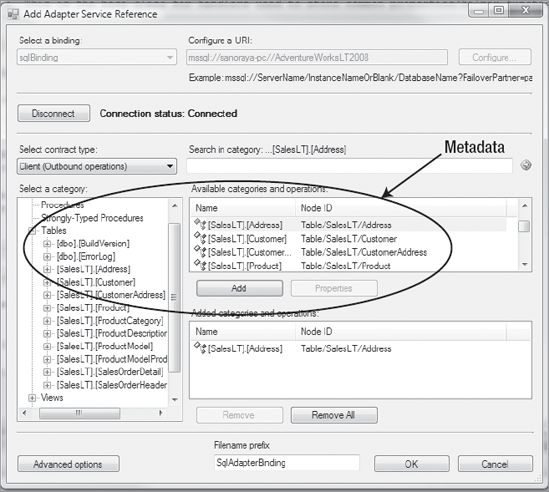You may now be asking yourself the following, quite
logical, question: if WCF LOB Adapters are built on top of the WCF
channel model, and if for consuming applications they even look like the
WCF services, what advantage then do WCF LOB Adapters offer over
classic WCF services? To answer this question, let's consider a typical
development cycle with WCF services. In a nutshell, the steps are as
follows:
Define the service contract.
Configure and host the service.
Build and configure client applications to consume the service.
Now imagine a situation when
your LOB application is, for example, DBMS-based. Further imagine that
as your application evolves, the number of stored procedures (or
metadata
in terms of ASDK) keeps growing. To expose the new operations to
external clients through WCF services, the service provider will either
have to update existing contracts or implement new ones by essentially
starting the cycle again.
1. Dynamic Metadata Discovery and Resolution
The issue is that WCF
contracts are static by its nature. If the underlying LOB application
changes and you want to make the new functionality available to external
clients, the existing contracts also have to change. In contrast, WCF
LOB Adapters offer dynamic metadata discovery and resolution at design
time. All changes in the underlying LOB system will be available
automatically.
Let's look at a concrete
example. As you likely know, BizTalk Server 2009 ships with a BizTalk
Adapter Pack containing adapters for major LOB systems built using ASDK.
Assume you are using the SQL Server Adapter from the pack to
communicate with your SQL Server-based LOB application. To generate a
proxy file for your .NET application, you will use the Add Adapter
Service Reference plug-in, as shown in Figure 1.
This plug-in functionally is similar to the Add Service Reference
dialog box that you use to generate a proxy for WCF services.
When new stored procedures
become available, adapter consumers who want to use those procedures
will of course have to regenerate proxies using the Add Adapter Service
Reference plug-in. The most important thing is that the new stored
procedures will be discovered by the adapter and show up in the plug-in
automatically, with no action required from the adapter developers.

Although the process
we've described sounds like magic, of course it is not. It is the sole
responsibility of the adapter developer to implement the interfaces to
enable adapter metadata capabilities. If that seems confusing, please
read on. After completing the walk-through later in the chapter, you'll
have a much clearer idea of how this "magic" actually happens.
As a general rule, Microsoft suggests the following guidelines for evaluating whether your organization will benefit from using ASDK.
You should consider writing adapter when:
the target system is an existing system that is not enabled for web services;
the target system is dynamic and can be enhanced with new operations;
the target system has a large amount of metadata;
there is a large, diverse number of users for the target system's data; or
consuming applications need rich application metadata discovery functionality.
You should use the WCF service or channel model to create a service when:
the target system is static and has a fixed set of operations;
the target system has little or no metadata;
service developers have detailed knowledge of the application to be exposed; or
a new application is being exposed.